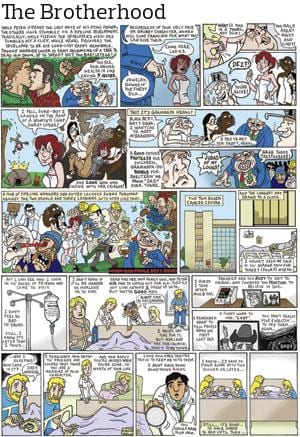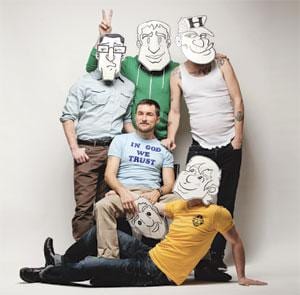
Credit: Shimon Karmel
Tyler Dorchester dreams about his comic strip The Brotherhood, sometimes waking up to scribble ideas on a memo pad, other times mentally composing on the mattress, and occasionally jumping out of bed.
Recently celebrating its 150th episode in Xtra Vancouver, the strip has been in the making since the early 1990s, when Dorchester began jotting ideas in a book, long before he conceived of the cartoon.
There are tabs in the two-inch-thick, sticky-note-filled binder with epiphanies for the self-righteous Henkl, moderate Ian, party-boy Myles, hunky tree-hugger Thomas and lovelorn Pete.
They’re amalgamations based on Dorchester’s friends, though Thomas’s counterpart isn’t HIV-positive and the real Henkl’s grandmother wasn’t a crossdressing cowboy.
The binder overflows with ideas.
How about a rich gay man trying to obtain the foreskin of Christ? A fitting folly for the iconoclastic atheist Henkl.
If an apocalypse turned people into cannibals, what would be the best baste for a leather daddy? A twink? An evangelical?
How about alien anal probes conducted by closeted Republicans trying to indulge their tendencies in disguise?
“A lot of them won’t go anywhere,” Dorchester says, referring to the ideas, not the anal probes. “They won’t germinate.”
Even a character hasn’t germinated. Dez the lesbian has no counterpart in his life, Dorchester says, because gays and lesbians segregate themselves in Vancouver. He might just have her self-reflect: “Sorry guys, but I don’t have anything to offer you. I’m sort of a token character because my artist really likes the boy-girls, but we run in different worlds.”
A rural Alberta native, Dorchester studied English and history. He moved to Vancouver in 2001 because he was “too much of a hippie for Alberta.” Out for half his life, the 38-year-old perennial bachelor describes his fictional counterpart, Pete, on his Facebook page as “perpetually luckless in love, dating is to him what the Road Runner is to Wile E Coyote.”
Dorchester rebuffs my questions about bachelorhood in his late 30s — “Don’t do that to me, man.” A moment later, he likens a relationship to a side dish: “If you had Thanksgiving dinner and the cranberry sauce was missing, you would not be bitching with your mouth full.”
He’s part geeky PC guy — bespectacled and self-deprecating.
“I’m going to like what I do maybe 10 years from no w,” he says. “Right now, I like about a third of what I do, and the rest is like — errrrhhhh — I almost had it but not quite.”
And he’s part cool Mac dude — quirky and unique. (He uses a Mac.)
The cartoon started out goofy, like Kids in the Hall, he says. Lately, it’s been verging away from strictly gay topics.
“If we kind of go down the path to the well-rounded individuals, the fact that we’re gay might end up third or sixth on our list,” he says. “We’re a husband first, or we’re an uncle first, or we’re a doctor above that.”
The storyline of the last year reflects on Pete’s returning, with his gay city and rural friends, to his rural roots in Alberta to be at his father’s deathbed.
Dorchester’s noble, gentle father, the family’s linchpin who raised — and accepted — Dorchester despite driving on the chuckwagon circuit of Canada’s heartland, died in 2008.
His father’s death made Dorchester realize “how important each person’s individual story is. And when they’re gone, you realize how many stories you’ll never hear, especially when it’s someone who’s been around for a while. They saw things that you’ll never be party to.”
The storyline melds with Dorchester’s near-death experience from Castleman’s disease, with which he was diagnosed two months before his father got cancer. The rare disease caused heart arrhythmia and kidney failure. At one point, he accumulated 13 pounds of water from his sternum down.
“When I was fading, it was in a very similar way to my dad,” he says. But a new treatment saved him.
Following the serious storyline, Dorchester says he’s eager to return to the cartoon’s goofy roots, and did so briefly in the fall, having Ian and Myles gleefully roleplay — erections prominently evident — first as Jesus and Santa, then as Britney and a paparazzo, a pirate and a mermaid, Winnie the Pooh and Eeyore, and Han Solo and Chewbacca.
“Anyone who stuck with me for all these verbose plots — here’s a bone,” Dorchester says, all puns intended.

 Why you can trust Xtra
Why you can trust Xtra


